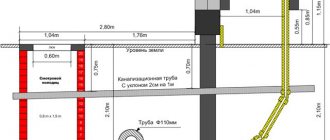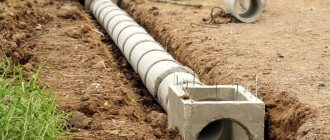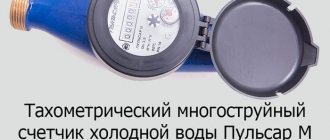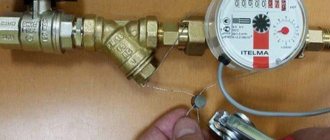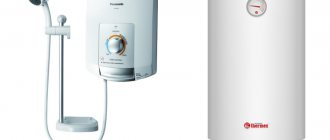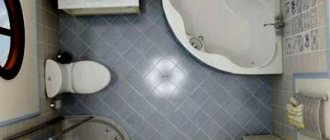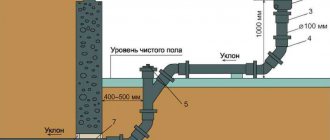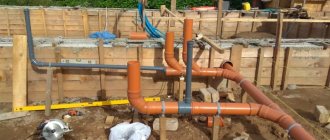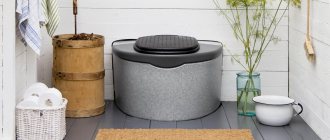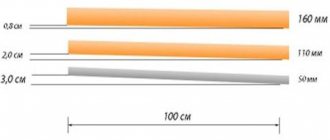Rules for installing a water meter
There are several fundamental rules for installing a water meter, violation of which can disrupt its operation.
- Water meters, both wet and dry, are installed both vertically and horizontally, which must be indicated in the technical characteristics of the water meter.
- It is prohibited to install water meters with the counting mechanism facing down.
- To ensure emergency operation of the water meter, it is necessary to install a coarse filter (mesh or magnetic) in the water metering unit on the water supply side.
- To repair or replace a water meter, at least two shut-off valves must be installed in the water meter unit before and after the water meter. Better installation, not only the installation of shut-off valves, but also the installation of an overlapped bypass line for the meter during the period of its repair (replacement).
How to choose a location for the device
Before installing the meter, you need to determine a suitable location for the device. To do this, assess the condition of the pipeline and the presence of branches from the riser. The meters can be mounted both horizontally and vertically. The main thing is that there should be a free approach to the device. The device is installed near the entry of the pipeline into the plumbing socket. In a private house, the distance of the meter from the pipe exit from the plumbing fixture is twenty centimeters.
As a rule, devices are attached to pipes that lead to a common riser, placing the meter after the shut-off valve. The most convenient placement is considered to be near the bathroom or sink. The linear section of the tube must be located from the insertion point of the device at the distance specified in the passport for the device. A mandatory requirement is to replace old locking elements with modern ball ones. For water supply of hot water from plastic, the tap marking DN25 is used, for cold water the marking DN15 is used.
Attention! The taps must withstand water temperatures of one hundred degrees or more, and also be resistant to high pressure. The number of meters depends on the number of risers in the house.
Installation diagram
This is what a classic water meter installation diagram looks like. This circuit works to measure water flow with the bypass valve (7) closed and valves (2) and (4) open. If it is necessary to repair or replace the water meter, valves (2) and (4) are closed, and water enters the house with valve (7) open through the bypass.
For example, let's look at the water metering unit of an apartment building. It looks more clear. The arrows show the direction of water flow into the house.
Pros and cons of self-installation
The advantages of self-installation are obvious:
- saving money on installation of devices;
- the ability to determine the date and time of installation at a convenient time for the owner of the apartment or house;
- independent choice of metering meter model based on ratings and reviews.
Disadvantages of DIY installation:
- risk of poor-quality installation of metering devices;
- increasing the likelihood of an emergency (especially in an apartment building);
- double costs associated with forced dismantling and re-installation of metering devices.
The owner must make a conscious decision: calculate the pros and cons of “home” installation of a water meter for hot and cold water consumption.
Rules for installing a water meter unit
If we transfer the rules for installing water metering units of an apartment building to a private house and make some amendments, we get the following:
To install a water meter unit, it is necessary to make a straight section of pipeline at least 6-8 pipe diameters long between the water meter and the inlet valve;
Despite the availability of vertically mounted vane water meters on sale, it is preferable to install the water meter on a horizontal section. We remember that the water meter cannot be installed with the window facing down;
It is not necessary that the diameter of the house pipeline coincides with the diameter of the water meter inlet/outlet. However, in the sections of the water meter assembly from valve (2) to valve (4), the diameters of the pipes must coincide with the water meter couplings;
If it is necessary to connect a water meter to a pipe of larger diameter, these are adapters installed behind the standard straight sections L=6-8×d.
The water meter itself is located at a height of 30-100 cm from the floor, at some distance from the wall, in a visually accessible place.
It is recommended to make a bracket to support the water meter from below. Also, all turns (if any) before and after the water meter must be secured;
On the water supply side, a coarse filter is installed in front of the meter. An arrow for water movement is marked on the filter housing.
©Elesant.ru
Articles on the topic
- Axonometric diagram of the water supply system
- Water tank of a private house
- Plumbing inside the building
- Water supply of a private house from an autonomous source
- Plumbing work in the apartment
- Water pipes made of cross-linked polyethylene
- Water supply to the apartment
- Axonometric diagram of the water supply system
- Water tank of a private house
- Plumbing inside the building
- Water supply of a private house from an autonomous source
- Plumbing work in the apartment
- Water pipes made of cross-linked polyethylene
- Water supply to the apartment
Principles for choosing a metering device
In order not to make a mistake before purchasing a water meter, you need to take into account the accuracy class of the device . The accuracy of water flow measurements depends on it, but the cost of the water meter will be higher.
Which one should I buy for DHW?
When purchasing a device for domestic hot water, most often the choice is made on tachometer devices.
Turbine models are used for pipelines with a diameter of 50 to 200 mm. For narrower sections (up to 40 mm), vane meters are used.
We advise you to adhere to the following features:
- pressure in the device is from 16 atmospheres or more;
- operating heating temperature range from 5 to 150 degrees Celsius;
- maximum sensitivity is equal to the average hourly passage of a volume of water;
- The permissible error should not exceed 5%.
On a note! The metering device must bear the manufacturer's seal. The technical passport contains the device number, test date and QC stamp. The seller adds information about the date of sale and the seal of the seller-store to the details.
ITELMA WFW20.D110
In terms of reliability and technical characteristics of mechanical meters, ITELMA WFW20.D110 (a joint German-Russian brand) is in 1st place.
Advantages:
- 6 year warranty;
- affordability.
"DecastMetronic" VSKM 90-15 DG
The vane water meter is convenient for main pipelines with low energy consumption.
Advantages:
- 10 year warranty;
- easy to repair;
- simple design.
The main disadvantage is that there is no mounting hardware for installation.
Zenner ETWI-N DN 15
The German model is one of the best mechanical universal water meters. The device uses a multi-jet operating principle.
Advantages:
- high build quality;
- accuracy of flow measurement;
- there is a function for transmitting values via Wi-Fi;
- long term - 12 years.
The only drawback is the price is higher than average for water meters.
It is recommended to take into account individual characteristics:
- what is the state of communications;
- approximate composition of water (hard or soft);
- availability of funds for purchase;
- indicators of heating water entering the system.
To assess financial capabilities, it is better to check with special organizations the approximate cost of installing equipment. Installing a water meter on your own is a troublesome and responsible undertaking.
Which one to buy for cold water supply?
Main characteristics of the cold water meter: temperature range up to 30 degrees Celsius. A distinctive feature from the GW device is the calibration interval. The difference will be in the timing of verification; usually a hot water meter requires more frequent verification.
For a water meter for cold water, the interval is 6 years, for hot water - from 4 to 6. High temperatures wear out the meter parts faster.
The color of the housing differs; for cold water, blue ones are often used; for hot water, a red meter is required. The diameter of the pipeline is taken into account, options are possible from the minimum (15 mm) to the maximum - 20 mm.
Important! When installing a water meter, the following rule is followed: a meter designed to measure the flow of cold liquid is placed on a cold pipe. It cannot be used for hot water!
Betar SHV15
In terms of operational capabilities for cold water, the Russian Betar SKHV15 meter is distinguished. There are three installation options: vertical, horizontal or at an angle. Permissible liquid temperature +5….+40 degrees Celsius, maximum pressure 10 Bar.
Advantages:
- with warranty 6, the service life can reach 18 years;
- low cost;
- convenient to install and operate.
NORM SVKM-25X
More expensive in price, but optimal in performance. It deservedly ranks 1st among premium models.
Advantages:
- brass body with anti-corrosion coating;
- compact, easy to install;
- there is magnetic protection against interference with the operation of the device;
- pulse output.
Practice shows that it is better to choose tachometer models for an apartment or private household .
They have an optimal balance of cost, quality, and ease of use.
Where should water meters be installed?
In most cases, there are no questions regarding where water meters are located in the apartment - they are usually placed in the area of pipelines that extend from the risers themselves with water (cold, hot, respectively), after the taps for shutting off immediately. In private houses, water meters are always installed in the place where the water pipe passes into the building itself. Most often, the installation location is the basement. An option of this kind represents the greatest optimality if you look at the situation from the perspective of the convenience of obtaining readings from the meter, as well as compliance with all the conditions that are associated with the operational process of the flowmeter itself.
However, in recent months, a special trend has begun to be observed: members of organizations involved in water supply issues have begun to actively present their demands to the owners of private houses regarding the placement of water meters in the area where a diversion from the central main line has been made. In this case, the metering device can end up both outside the walls of the building and outside the entire site. Plus, for it to be placed, the user will have to equip a special type of well.
Water supply companies are accustomed to justifying such a requirement by the fact that limiting the possibility of liquid consumption by bypassing the metering device is a procedure necessary due to illegal cuttings. According to this explanation, we can fully judge that water meters must be moved even by those home owners who have had the meter installed for a long time and have been in operation for several years, but now they will have to replace it.
In principle, there is no legal basis to support the rule on the basis of which water supply companies demand that owners bear additional costs, as well as install water meters outside the territory of a private building. This has been repeatedly confirmed in the results of court proceedings regarding this controversial issue. The organization supplying water must keep the device registered, regardless of where it was installed. The most important thing is that the device itself is mounted in accordance with the requirements, which are designed to ensure maximum measurement accuracy. It is also very important that the counter works correctly.
Of course, the complete wiring of the water supply network throughout the building must be carried out after the metering device.
Photo
Water meters in a private apartment
Installation of water meters in a box
Water meter installation
Work on connecting water meters
General rules
It doesn’t matter whether you are going to install a cold or hot water meter in a country house or apartment. The same rules and requirements apply for the installation of these devices. So when installing a water meter in your house, you should adhere to the following rules:
- To avoid being denied registration of a meter, choose cold and hot water meters that are certified in the Russian Federation.
- The water meter must be installed using a coarse filter, which is installed before the meter. Thanks to the filtration device, fewer dense particles will enter the unit, which can lead to wear of mechanical parts and failure of the water meter. This connection reduces the likelihood of damage to the impeller and increases the accuracy of the water meter.
- Sometimes installation rules require installing a check valve. This will protect the impeller from rotating in the opposite direction and will not allow owners to rewind the readings using a vacuum cleaner.
- The meter must be installed in the apartment at a distance of no more than 20 cm from the entrance to the main pipeline. This installation location will not allow you to insert into the pipeline to the metering unit. However, in a country house or dacha, a different rule applies.
- A room in which the temperature will not drop below 5 degrees all year round is suitable for installing a water meter.
- Meter readings are considered valid and can be taken into account when paying for utilities only after the unit has been sealed. To do this, you need to invite a representative of the management company.
When purchasing a water meter, make sure that it has a technical passport, and also check the number from the document with the serial number on the water meter body. They should be the same. The readings on the board do not matter, since they will be recorded in the accounting card, and further calculation of water consumption volumes will be made from them.
Choosing a hot water meter and operating rules
Install it yourself or through a company?
According to current legislation, the installation of water meters is at the expense of the home owner. That is, you must buy a meter and install it at your own expense. Representatives of the water utility or DEZ seal installed water meters free of charge.
Self-installation procedure
Self-installation of water meters is possible. Nobody should object. You just have to do everything yourself - install the meter, and call a representative of the housing office to seal it. What you need:
- purchase a meter and all the necessary parts;
- negotiate and pay for disconnecting the cold/hot water riser (contact the maintenance company, set a date and time);
- install the meter, turn on the water;
- call a representative of the water utility or DEZ (in different regions) to seal it, receive the commissioning certificate in hand;
- go with the certificate and passport of the metering device (there must be a serial number, store stamp, factory verification date) to the DEZ and register the water meter.
Self-installation of water meters is not prohibited
All papers are reviewed, a standard contract is filled out, you sign it, and at this point it is considered that you pay for water according to the meter.
Read how to choose a water meter here.
How to hire a good firm and what they should do
There are two ways to find a company that installs water meters: take the list from the Economic Protection Agency or find it on the Internet yourself. The list will definitely include companies with licenses, but obviously not all of them that work in this area. On the Internet, you must check for a license. A copy of it should be posted on the website.
Then, in any case, you should read the standard agreement that the company will conclude with you. It must contain a complete list of services. The conditions may be different - someone provides their own meter, someone installs yours, someone comes with their own spare parts, someone works with what the owner has. Based on the combination of the list of services provided, you make a choice.
Without much hassle, but for decent money
Previously, the contract contained a clause on service maintenance, and without it, companies did not want to install meters. Today this clause is recognized as illegal, since in fact there is no need to service the meter, and it should not be in the agreement, and if it is, you have the right to refuse these services and not pay for them.
Read how to choose polypropylene pipes here.
Preparing for installation
If you have not chosen any campaign, you must leave a request to them. There are two options - some companies accept applications on their website and may even offer a discount for this, while others prefer to see you in the office and sign an agreement.
First, company representatives inspect the installation site
In any case, first a representative of the campaign arrives (you agree on the date and time of arrival), inspects the “field of activity,” assesses the condition of the pipes, takes measurements, and often takes photos of communications. All this is necessary so that you can develop a meter connection diagram and quickly assemble it. Then they should call you and confirm the date and time of installation of the water meter. In this conversation, you need to find out who negotiates the disconnection of the risers with the operational campaign. Normal companies take care of this.
Installation of water meters by campaign representatives
At the appointed time, a campaign representative (sometimes two) arrives and does the work. In theory, they should agree with you on what and how to place it, but this does not always happen. Upon completion of the work (usually takes about 2 hours), they give you a certificate of completion and a special paper on which the serial numbers of the metering devices are written. After this, you must call a representative of the government water supply company or DEZ to seal the meter (different organizations do this in different regions). Sealing of meters is a free service, you only need to coordinate the time.
If the pipes are in normal condition, installation of water meters by professionals takes about 2 hours
The certificate that you were given during installation must contain the initial meter readings (they differ from zero, since the device is verified at the factory). With this act, a photocopy of the organization’s license and the passport of your water meter, you go to the DEZ and sign a standard agreement.
Some subtleties and nuances
When purchasing a meter, you need to make sure that the number in the passport matches the number stamped on the water meter. The device must also bear a sign that it has been certified. The passport must have a stamp with the date of factory verification. The “newer” the date, the better - the more likely it is that you will not be forced to check it before installation. Another necessary detail is a store record of the sale with a stamp. If the meter malfunctions, you will be given a certificate with which you can demand its replacement.
EU and Russian certification marks
It is also very desirable that the factory verification date be “more recent” - you will not have to carry the device for verification longer.
Installation features
When installing water meters, all threaded connections must be sealed - the pressure in the lines is serious. For this, linen winding or fum tape is used. If you use a winder wound around a thread, it is advisable to lubricate it with packaging paste - it will make the work easier. The fum tape does not need lubrication, it is itself elastic.
One important point: when tightening connections, do not use excessive force - microcracks may appear, which will then lead to leakage of the connection.
If you have steel pipes coming from the riser outlet, you will need welding or a grinder to cut off the now unnecessary piece. You will also need to cut a thread at the end of the pipe (if there is none) - this is the only way to connect the shut-off valve. On the reverse side the situation is the same - you will need either a transition fitting or thread cutting.
Flow direction
When assembling all the parts, pay attention that there is an arrow on the body of each. It may not be there except on the ball valve, since it doesn’t care in which direction the water flows. Although, if installed incorrectly, you will have to turn the handle in a different direction, but this is not fatal. For other devices - meter, filter, check valve and reducer - the direction of flow is critical. Therefore, when assembling, position them so that the water flow follows the arrow. This is really important.
If there are no arrows on the body of the listed parts, most likely you have the cheapest and possibly low-quality part. If possible, it is better to replace it with a normal one; if not, find out the direction of the flow yourself; by examining the structure, you can understand where the flow should move.
Follow the direction of the flow and make a marking first
As you can see, installing water meters with your own hands is possible, but there are quite a lot of features. And one more thing: when you negotiate to turn off the risers, ask not for two hours, but better for four. And pre-assemble everything without winding, measure the length, figure out where and how everything will be placed, draw where to cut, weld, install retaining clips (if the pipeline is made of polypropylene), etc. In general, do as much preparation as possible. In this case, installing water meters yourself will take place with a minimum of hassle.
Preparation for installation work
Procedure before installing the IPU:
- All necessary devices and components are purchased and mounting space is freed up. It is advisable to agree on the installation site in advance to avoid problems. It is important to choose the right water meter: according to SNIP 04.01-85, the placement of the mechanism must take into account the sensitivity threshold. Therefore, you should pay attention to the designation: symbol B (B*H) - the product must be placed horizontally, A (A*V) - vertically. If both options are present, then the IPU is universal.
- When a new device is introduced into the system, the inlet shut-off valve should be checked. If the ball valve is working properly, then there is no need to coordinate the installation, but you need to write an application to the service company to invite a specialist to put the IPU into operation. If it is impossible to completely shut off the water or when replacing part of the system, it is necessary to agree on the time to turn off the riser. This is not required if a plumber from a home maintenance company is hired to do the work.
- It is also necessary to contact the Criminal Code when reinstalling the mechanism. The specialist will take readings, after which the filling can be removed.
On a note! DHW IPUs are universal and suitable for installation on all pipes, but cold water meters can only be used for cold water.
Operating principles of water metering devices
The State Register, which contains measuring instruments of the Russian Federation, has registered up to 500 types of devices intended for liquid consumption (hot, cold).
Meters perform their functions according to different principles. Depending on this, they can be divided into:
Tachometer meters. In them, usually the water flow, which passes through the meter itself, can have a direct impact on the turbine or impeller. The turbine is usually installed in the inside of the device housing. The rotational movement of the turbine is usually subject to conversion with the help of a special organism into figures for the consumption of digital water resources. According to the design of the meters, they are divided into “dry” and “wet”.
In a measuring device whose design is “wet”, the mechanism is a transducer, washed by a stream of water that passes through the measuring device. The circuit itself is inexpensive, but allows for maximum accuracy and reliability.
The most important disadvantage is the high level of sensitivity to mechanical impurities that may be present in the water mass. Metering devices that operate according to the “dry” scheme do not suffer from this feature.
The metering mechanism is located in a hermetically sealed box, which is made of a material that cannot be affected by a magnetic field. Registration of rotations of turbines and impellers is carried out using 2 magnetic inserts. This device is much more expensive in terms of cost.
- Metering devices of electromagnetic type. Housing design of such a measuring device
may resemble a Michael Faraday coil. The water flow passing through the device acts as a core during movement. Thanks to the force with which the induced current works, it is possible to easily determine at what speed the flow passes. If you also know what type of cross-section the outlet pipe has, then you can calculate the volume that has passed per unit of time. This device offers a high degree of accuracy, but purchasing it can be very costly for the homeowner. If a breakdown occurs, the device cannot be repaired. - Ultrasonic metering devices. In them, the speed at which the flow passes is determined by comparing the speed of sound according to the following parameters: in the direction of water movement and against the direction of water movement. They have high accuracy and reliability, but due to their high cost, they are purchased much less frequently than the metering devices that were described in the text above.
If the device will be used at home, then the best option would be to purchase a tachometer meter for hot and cold water. And it is best to take a device that works with a “wet” circuit.
Service life and verification of meters
The owner of the premises is obliged to confirm the operability of the IPU within the prescribed period. The interval is set by the manufacturer and indicated in the product passport. It is taken into account that it is from the factory verification that the period until the next one is calculated: for DHW metering devices - 4 years, for hot water supply - 6 years. Learn more about how to check water meters at home without removing them.
When assessing the functioning, which can only be carried out by an accredited organization, attention is paid to the maximum service life of the mechanism - 12 years.
Wireless technology to choose from
We offer solutions based on two wireless technologies: the familiar Wi-Fi and the cutting-edge NB-IoT. Each technology has its own advantages.
Smart Wi-Fi meters
- Without additional payments, you only pay for the equipment.
- No SIM cards or communication towers required Data is transmitted via your home Wi-Fi network.
- Three batteries for 4 years Works without 220V in a plumbing closet.
- Easy setup Via any web browser or mobile app.
Smart meters NB-IoT
- 6-year traffic package included No need to buy a SIM card or monitor your balance.
- Without hubs, routers and towers Data is transmitted via the NB-IoT network from MTS.
- Up to 6 years without battery replacement Operates without 220V. Easy battery replacement.
- High signal penetration Works where GSM and Wi-Fi do not work.
| Don't know what to choose? Write to us via online chat or request a call back | Request a call |
How it works
Controller
accumulates readings throughout the day and transmits them to the SAURES cloud once a day.
Cloud
stores an archive of readings, provides access to data from the web account or mobile application
Sending service
automatically transmits readings to the mos.ru portal, your management company, HOA or SNT.
- You don't need to worry about sending readings every month; smart meters will send them automatically.
- Automatic sending of readings protects against problems with incorrect rent calculations, unnecessary recalculations and paying for water “on average”.
- You save on utility bills because you have full control over your consumption and use water more efficiently.
- You are protected from wasted water due to a leaking faucet, a stuck toilet button or a leaking fitting.
